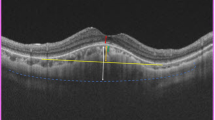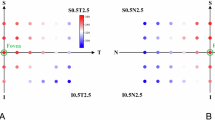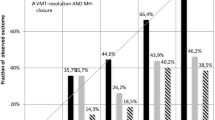Abstract
Objectives
To investigate dome-shaped macula (DSM) in mild myopic or non-myopic eyes.
Methods
Participants aged 50 years or older were recruited from July 2023 to August 2023. Clinical features including age, sex, visual acuity (VA), spherical equivalent refraction (SER), ocular biometry parameters, SS-OCT parameters and macular complications were compared between eyes with and without DSM. Logistic analysis was performed to explore risk factors for DSM.
Results
923 eyes were enrolled in the final analysis. The overall prevalence of DSM was 3.03% (28/923). Among eyes with DSM, 13 eyes (46.4%) were emmetropia, 9 eyes (32.1%) were hypermetropia, and 6 eyes (21.4%) were myopia, with 4 eyes (14.3%) were mild myopia and one eye (3.6%) was moderate myopia. The mean subfoveal choroidal thickness (SFCT) in eyes with DSM was 168.00 ± 77.79μm, which was significantly thinner than their counterparts absent of DSM (289.11 ± 95.58μm, p < 0.001). Logistic regression revealed that longer AL (odds ratio (OR) = 1.716, 95%CI: 1.205-2.442, p = 0.003) and female sex (OR = 3.330, 95% CI: 1.109-10.005, p = 0.032) were associated with DSM. No vitreomacular complication including epiretinal membrane (ERM), vitreomacular traction (VMT), lamellar macular hole (LMH) and full-thickness macular hole (FTMH) was found in eyes with DSM, while the overall prevalence of those macular complications in eye without DSM was 8.8% (79/895).
Conclusions
The study offered a detailed profile of DSM in mild myopic or non-myopic eyes and found a diffuse thinning of choroid in both foveal and parafoveal area in eyes with DSM. No case with vitreomacular complications was identified in DSM eyes in our study population.
Trail registration
The registration number of the present trial in the Chinese Clinical Trial Registry is ChiCTR2000037944.
This is a preview of subscription content, access via your institution
Access options
Subscribe to this journal
Receive 18 print issues and online access
269,00 € per year
only 14,94 € per issue
Buy this article
- Purchase on SpringerLink
- Instant access to full article PDF
Prices may be subject to local taxes which are calculated during checkout

Similar content being viewed by others
Data availability
The data are stored in the form of paper materials in the Epi-data database, which are available on reasonable request.
References
Gaucher D, Erginay A, Lecleire-Collet A, Haouchine B, Puech M, Cohen SY, et al. Dome-shaped macula in eyes with myopic posterior staphyloma. Am J Ophthalmol. 2008;145:909–14.
Zhao X, Ding X, Lyu C, Li S, Lian Y, Chen X, et al. Observational study of clinical characteristics of dome-shaped macula in Chinese Han with high myopia at Zhongshan Ophthalmic Centre. BMJ Open. 2018;8:e021887.
Fang D, Zhang Z, Wei Y, Wang L, Zhang T, Jiang X, et al. The morphological relationship between dome-shaped macula and myopic retinoschisis: a cross-sectional study of 409 highly myopic eyes. Invest Ophthalmol Vis Sci. 2020;61:19.
Coco RM, Sanabria MR, Alegria J. Pathology associated with optical coherence tomography macular bending due to either dome-shaped macula or inferior staphyloma in myopic patients. Ophthalmologica. 2012;228:7–12.
Liang IC, Shimada N, Tanaka Y, Nagaoka N, Moriyama M, Yoshida T, et al. Comparison of clinical features in highly myopic eyes with and without a dome-shaped macula. Ophthalmology. 2015;122:1591–1600.
Jain M, Gopal L, Padhi TR. Dome-shaped maculopathy: a review. Eye (Lond). 2021;35:2458–67.
Kumar V, Verma S, Azad SV, Chawla R, Bhayana AA, Surve A, et al. Dome-shaped macula-review of literature. Surv Ophthalmol. 2021;66:560–71.
Errera MH, Michaelides M, Keane PA, Restori M, Paques M, Moore AT, et al. The extended clinical phenotype of dome-shaped macula. Graefes Arch Clin Exp Ophthalmol. 2014;252:499–508.
Dormegny L, Liu X, Philippakis E, Tadayoni R, Bocskei Z, Bourcier T, et al. Evolution of dome-shaped macula is due to differential elongation of the eye predominant in the peri-dome region. Am J Ophthalmol. 2021;224:18–29.
Giordano L, Friedman DS, Repka MX, Katz J, Ibironke J, Hawes P, et al. Prevalence of refractive error among preschool children in an urban population: the Baltimore Pediatric Eye Disease Study. Ophthalmology. 2009;116:739–46 746.e731-734.
Muller PL, Kihara Y, Olvera-Barrios A, Warwick AN, Egan C, Williams KM, et al. Quantification and predictors of OCT-based macular curvature and dome-shaped configuration: results from the UK Biobank. Invest Ophthalmol Vis Sci. 2022;63:28.
Iribarren R. Crystalline lens and refractive development. Prog Retin Eye Res. 2015;47:86–106.
Zhang Y, Zhang Q, Li SZ, He MG, Li SN, Wang NL. Anterior segment characteristics and risk factors for primary angle closure disease with long axial lengths: the handan eye study. Invest Ophthalmol Vis Sci. 2023;64:8.
Ellabban AA, Tsujikawa A, Matsumoto A, Yamashiro K, Oishi A, Ooto S, et al. Three-dimensional tomographic features of dome-shaped macula by swept-source optical coherence tomography. Am J Ophthalmol. 2013;155:320–328 e322.
Ohsugi H, Ikuno Y, Oshima K, Yamauchi T, Tabuchi H. Morphologic characteristics of macular complications of a dome-shaped macula determined by swept-source optical coherence tomography. Am J Ophthalmol. 2014;158:162–170 e161.
Caillaux V, Gaucher D, Gualino V, Massin P, Tadayoni R, Gaudric A. Morphologic characterization of dome-shaped macula in myopic eyes with serous macular detachment. Am J Ophthalmol. 2013;156:958–967.e951.
Shin E, Park KA, Oh SY. Dome-shaped macula in children and adolescents. PLoS One. 2020;15:e0227292.
Garcia-Ben A, Kamal-Salah R, Garcia-Basterra I, Gonzalez Gomez A, Morillo Sanchez MJ, Garcia-Campos JM. Two- and three-dimensional topographic analysis of pathologically myopic eyes with dome-shaped macula and inferior staphyloma by spectral ___domain optical coherence tomography. Graefes Arch Clin Exp Ophthalmol. 2017;255:903–12.
Imamura Y, Iida T, Maruko I, Zweifel SA, Spaide RF. Enhanced depth imaging optical coherence tomography of the sclera in dome-shaped macula. Am J Ophthalmol. 2011;151:297–302.
Dai F, Li S, Wang Y, Li S, Han J, Li M, et al. Correlation between posterior staphyloma and dome-shaped macula in high myopic eyes. Retina. 2020;40:2119–26.
Fajardo Sanchez J, Chau Ramos CE, Roca Fernandez JA, Urcelay Segura JL. Clinical, fundoscopic, tomographic and angiographic characteristics of dome shaped macula classified by bulge height. Arch Soc Esp Oftalmol. 2017;92:458–63.
Chebil A, Ben Achour B, Chaker N, Jedidi L, Mghaieth F, El Matri L. [Choroidal thickness assessment with SD-OCT in high myopia with dome-shaped macula]. J Fr Ophtalmol. 2014;37:237–41.
Viola F, Dell’Arti L, Benatti E, Invernizzi A, Mapelli C, Ferrari F, et al. Choroidal findings in dome-shaped macula in highly myopic eyes: a longitudinal study. Am J Ophthalmol. 2015;159:44–52.
Soudier G, Gaudric A, Gualino V, Massin P, Nardin M, Tadayoni R, et al. Macular choroidal thickness in myopic eyes with and without a dome-shaped macula: a case-control study. Ophthalmologica. 2016;236:148–53.
Keane PA, Mitra A, Khan IJ, Quhill F, Elsherbiny SM. Dome-shaped macula: a compensatory mechanism in myopic anisometropia? Ophthalmic Surg Lasers Imaging. 2012;43:e52–54.
Lee GW, Kim JH, Kang SW, Kim J. Structural profile of dome-shaped macula in degenerative myopia and its association with macular disorders. BMC Ophthalmol. 2020;20:202.
Zhu X, He W, Zhang S, Rong X, Fan Q, Lu Y. Dome-shaped macula: a potential protective factor for visual acuity after cataract surgery in patients with high myopia. Br J Ophthalmol. 2019;103:1566–70.
Mirza RG, Johnson MW, Jampol LM. Optical coherence tomography use in evaluation of the vitreoretinal interface: a review. Surv Ophthalmol. 2007;52:397–421.
Funding
The study was funded by the Capital’s Funds for Health Improvement and Research (Grant No. 2022-1-2052).
Author information
Authors and Affiliations
Contributions
SL designed the study; SL, CL and ML conducted the study and examined the subjects; ML, FX and ZL analysed the images and data; YZ provided advice on the data analyses; ML wrote the manuscript; SL reviewed and edited the manuscript; SL is the guarantor for the text in this article.
Corresponding author
Ethics declarations
Competing interests
The authors declare no competing interests.
Ethics approval
The study was approved by the Beijing Tongren Hospital Ethics Committee, Capital Medical University (Approval No. TRECKY2019-071). The procedure was performed in accordance with the principles of the Declaration of Helsinki. The informed consent form was signed by all participants attending this study. The registration number in the Chinese Clinical Trial Registry is ChiCTR2000037944.
Additional information
Publisher’s note Springer Nature remains neutral with regard to jurisdictional claims in published maps and institutional affiliations.
Rights and permissions
Springer Nature or its licensor (e.g. a society or other partner) holds exclusive rights to this article under a publishing agreement with the author(s) or other rightsholder(s); author self-archiving of the accepted manuscript version of this article is solely governed by the terms of such publishing agreement and applicable law.
About this article
Cite this article
Li, M., Li, Z., Xiang, F. et al. Clinical characteristics of dome-shaped macula in mild myopic or non-myopic eyes. Eye 39, 1787–1792 (2025). https://doi.org/10.1038/s41433-025-03756-8
Received:
Revised:
Accepted:
Published:
Issue Date:
DOI: https://doi.org/10.1038/s41433-025-03756-8



